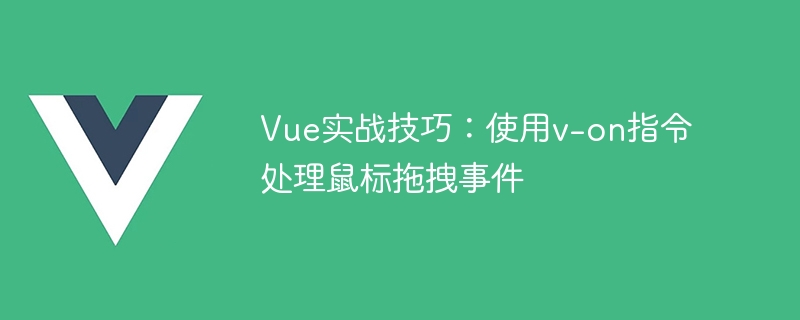Vue實戰技巧:使用v-on指令處理滑鼠拖曳事件
- 王林原創
- 2023-09-15 08:24:271186瀏覽

Vue實戰技巧:使用v-on指令處理滑鼠拖曳事件
前言:
Vue.js 是一個流行的JavaScript框架,它的簡潔易用和靈活性使得它成為了許多開發者的首選。在Vue應用程式開發中,處理使用者互動事件是必不可少的技能。本文將介紹如何使用Vue的v-on指令來處理滑鼠拖曳事件,並提供具體的程式碼範例。
-
建立Vue實例:
首先,在HTML檔案中引入Vue.js的程式庫檔案:<script src="https://cdn.jsdelivr.net/npm/vue"></script>
然後,建立一個Vue實例:
<div id="app"> ... </div> <script> var app = new Vue({ el: '#app', data: { ... }, methods: { ... } }); </script> -
新增原始資料:
為了實現滑鼠拖曳功能,我們需要定義一些用於控制拖曳元素位置的資料。在Vue實例的data選項中加入以下程式碼:data: { dragging: false, // 标记是否正在拖拽 x: 0, // 鼠标在页面上的横坐标 y: 0, // 鼠标在页面上的纵坐标 left: 0, // 拖拽元素的左侧偏移量 top: 0 // 拖拽元素的顶部偏移量 } -
綁定滑鼠事件:
透過v-on指令,我們可以方便地綁定DOM元素的滑鼠事件。在Vue實例的methods選項中加入以下程式碼:methods: { handleMouseDown: function(event) { this.dragging = true; this.x = event.pageX; this.y = event.pageY; }, handleMouseMove: function(event) { if (this.dragging) { var dx = event.pageX - this.x; var dy = event.pageY - this.y; this.left += dx; this.top += dy; this.x = event.pageX; this.y = event.pageY; } }, handleMouseUp: function() { this.dragging = false; } }程式碼解析:
- handleMouseDown:當滑鼠按下時,設定dragging為true,並記錄滑鼠在頁面上的位置。
- handleMouseMove:當滑鼠移動時,根據滑鼠位置的變化計算出元素的偏移量,並更新left和top的值。
- handleMouseUp:當滑鼠放開時,設定dragging為false。
-
新增拖曳元素:
在HTML檔案中,在適當的位置新增一個拖曳元素:<div v-on:mousedown="handleMouseDown" v-on:mousemove="handleMouseMove" v-on:mouseup="handleMouseUp" v-bind:style="{left: left + 'px', top: top + 'px'}" ></div>程式碼解析:
- v-on:mousedown:綁定滑鼠按下事件。
- v-on:mousemove:綁定滑鼠移動事件。
- v-on:mouseup:綁定滑鼠放開事件。
- v-bind:style:根據left和top的值動態設定元素的位置。
完整的程式碼範例如下:
<div id="app">
<div v-on:mousedown="handleMouseDown"
v-on:mousemove="handleMouseMove"
v-on:mouseup="handleMouseUp"
v-bind:style="{left: left + 'px', top: top + 'px'}"
></div>
</div>
<script>
var app = new Vue({
el: '#app',
data: {
dragging: false,
x: 0,
y: 0,
left: 0,
top: 0
},
methods: {
handleMouseDown: function(event) {
this.dragging = true;
this.x = event.pageX;
this.y = event.pageY;
},
handleMouseMove: function(event) {
if (this.dragging) {
var dx = event.pageX - this.x;
var dy = event.pageY - this.y;
this.left += dx;
this.top += dy;
this.x = event.pageX;
this.y = event.pageY;
}
},
handleMouseUp: function() {
this.dragging = false;
}
}
});
</script>總結:
透過使用Vue的v-on指令,我們可以輕鬆地處理滑鼠拖曳事件。本文透過具體的程式碼範例,詳細介紹如何實現一個簡單的拖曳功能。希望讀者能夠掌握這項實戰技巧,並在自己的Vue應用中運用。
以上是Vue實戰技巧:使用v-on指令處理滑鼠拖曳事件的詳細內容。更多資訊請關注PHP中文網其他相關文章!
陳述:
本文內容由網友自願投稿,版權歸原作者所有。本站不承擔相應的法律責任。如發現涉嫌抄襲或侵權的內容,請聯絡admin@php.cn

